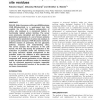NAR
2007
14 years 9 months ago
2007
PAR-3D (http://sunserver.cdfd.org.in:8080/protease /PAR_3D/index.html) is a web-based tool that exploits the fact that relative juxtaposition of active site residues is a conserve...
NAR
1998
14 years 9 months ago
1998
The PROMISE (Prosthetic centres and metal ions in protein active sites) database aims to gather together comprehensive sequence, structural, functional and bibliographic informati...
90
Voted
BMCBI
2008
14 years 10 months ago
2008
Background: Identifying the active site of an enzyme is a crucial step in functional studies. While protein sequences and structures can be experimentally characterized, determini...
BMCBI
2007
14 years 10 months ago
2007
Background: Approximately 5% of Pfam families are enzymatic, but only a small fraction of the sequences within these families (<0.5%) have had the residues responsible for cata...
APBC
2004
14 years 11 months ago
2004
THEMATICS (Theoretical Microscopic Titration Curves) is a simple, reliable computational predictor of the active sites of enzymes from structure. Our method, based on well-establi...
85
Voted
AIIA
2007
Springer
15 years 2 months ago
2007
Springer
One of the aims of modern Bioinformatics is to discover the molecular mechanisms that rule the protein operation. This would allow us to understand the complex processes involved i...




